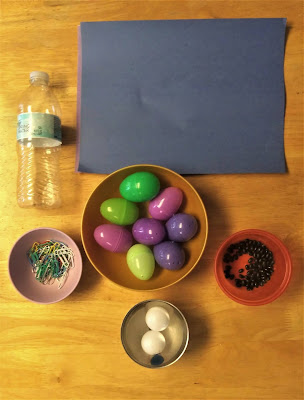Exploring and experimenting with sound has fascinated both children and adults for centuries. The following activity is designed to help children explore the world of sound while simultaneously building cognitive and auditory-discrimination skills.
Age Group: This activity is very moldable and can be used with children ranging from 3-5 years
Type of Activity: This activity is designed to be done either one on one with a child or with a small group of children as close adult supervision is required.
Learning Objective:
Children will build their auditory-discrimination and categorization skills by matching sounds.
Materials:
- An even number of hollow plastic eggs or empty plastic bottles
- Paper
- Tape
- Small household items to fill the eggs or bottles such as rice, dry beans, loose change, or paper clips.
Completing the Activity:
To complete this activity, you will need to start by setting out an even number of plastic eggs. Fill the eggs with small items from around your house that will make a noise when you shake them inside the eggs. For my eggs, I used pennies, ping-pong balls, dried beans, and paperclips. Make sure you create matching pairs for each sound. For example, I had two eggs with pennies inside, two eggs with dried beans, etc.
Once you have your eggs or bottles filled, set them out on a table. Invite children over and encourage them to try shaking the eggs or bottles to see what they sound like. Make sure to explain that they can't open the eggs or bottles yet. Build children's vocabulary by talking with them about the different sounds and helping them describe what they hear. Once children have had a chance to explore the eggs or bottles, explain to them that the idea is to find two that sound the same. Help children take turns shaking the eggs and trying to find a match. Once they think they have a match, allow them to open the eggs to see if they got it right. If not, have them close them up and try again. The game ends when all of the eggs have been matched; however, you can keep replaying the game as many times as you want. As children play, watch to see whether or not they can correctly match the eggs. If children struggle, you may need to take a turn and demonstrate how to find a match. Also, you may want to try only setting out 4-6 eggs. Once children have mastered matching a few choices, you can add in more eggs.
What Children Will Learn:
As children play the matching game they...
Practice cognitive skills- As children listen to the different sounds and find matches, they practice the cognitive skill of categorization by exploring which items make a loud or soft sound and which eggs sound the same.
Practice language skills- As children play the game and discuss what they hear, they learn new words to describe sounds. Also, as children work to find eggs that sound the same, they develop their auditory- discrimination skills. The ability to discriminate between different sounds is a critical skill needed to produce and understand spoken language.
Adapting and Expanding the Activity:
- For children who are Deaf or hard-of-hearing, fill the eggs or bottles with items that feel different when you shake them. For example, fill one set with pebbles and another with paper clips. Focus on having the children match the eggs or bottles that feel the same when you shake them.
- Build children's cognitive skills by having them make predictions about what is inside each egg based on the sound.




















